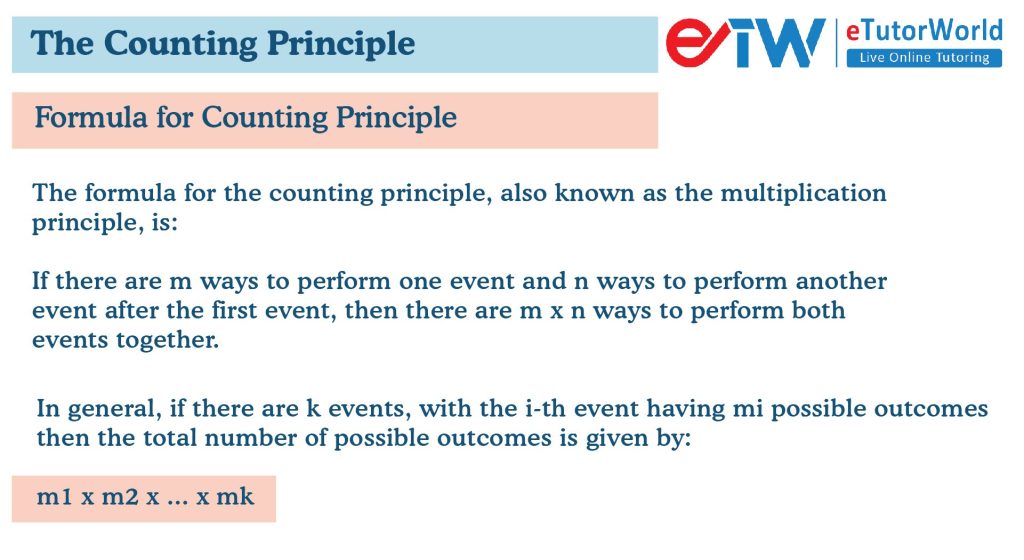The Counting Principle
Grade 7 Math Worksheets
The Counting Principle, or Multiplication Principle, is a fundamental rule in combinatorics used to count the number of possible outcomes in a sequence of events.
Table of Contents:
- The Counting Principle
- Example of the Counting Principle
- Formulae of Counting Principle
- FAQs
Personalized Online Tutoring
The Counting Principle - Grade 7 Math Worksheet PDF
This is a free worksheet with practice problems and answers. You can also work on it online.
Sign up with your email ID to access this free worksheet.
"We really love eTutorWorld!"
"We really love etutorworld!. Anand S and Pooja are excellent math teachers and are quick to respond with requests to tutor on any math topic!" - Kieran Y (via TrustSpot.io)
"My daughter gets distracted easily"
"My daughter gets distracted very easily and Ms. Medini and other teachers were patient with her and redirected her back to the courses.
With the help of Etutorworld, my daughter has been now selected in the Gifted and Talented Program for the school district"
- Nivea Sharma (via TrustSpot.io)
The Counting Principle
The counting principle, or multiplication principle, is a fundamental rule in combinatorics used to count the number of possible outcomes in a sequence of events. It states that if m ways to perform one event and n ways to perform another after the first event, then there are m x n ways to perform both events together.
For example, consider a person who has 3 shirts and 4 pants. The multiplication principle gives the total number of ways to choose one shirt and pair of pants: 3 x 4 = 12. Therefore, 12 different outfits can be created using these shirts and pants.
The multiplication principle can be extended to more than two events. For instance, if m ways to perform the first event, n ways to perform the second event, and p ways to perform the third event, then there are m x n x p ways to perform all three events together.
The multiplication principle is an essential concept in probability theory, as it is often used to count the number of possible outcomes in a sample space. It can also be used in other areas of mathematics and science, such as computer science, physics, and economics.
Example of the Counting Principle
Here’s an example of the counting principle:
Suppose you have 4 shirts and 3 pairs of pants. How many different outfits can you create using one shirt and one pant?
Using the counting principle, we multiply the number of ways to choose a shirt (4) by the number of ways to choose a pant (3):
4 x 3 = 12
Therefore, 12 different outfits can be created using these shirts and pants. These outfits are:
- Shirt 1 and Pant 1
- Shirt 1 and Pant 2
- Shirt 1 and Pant 3
- Shirt 2 and Pant 1
- Shirt 2 and Pant 2
- Shirt 2 and Pant 3
- Shirt 3 and Pant 1
- Shirt 3 and Pant 2
- Shirt 3 and Pant 3
- Shirt 4 and Pant 1
- Shirt 4 and Pant 2
- Shirt 4 and Pant 3
So, using the counting principle, we can see that there are 12 different outfits that can be created by choosing one shirt and one pant.
“There have been times when we booked them last minute, but the teachers have been extremely well-prepared and the help desk at etutorworld is very prompt.
Our kid is doing much better with a higher score.”
7th Grade Tutoring
eTutorWorld offers Personalized Online Tutoring for Math, Science, English, and Standardised Tests.
Our Tutoring Packs start at just under $22.49 per hour, and come with a moneyback guarantee.
Schedule a FREE Trial Session, and experience quality tutoring for yourself. (No credit card required.)
Formulae of the Counting Principle
The formula for the counting principle, also known as the multiplication principle, is:

If there are m ways to perform one event and n ways to perform another event after the first event, then there are m x n ways to perform both events together.
This can be extended to more than two events:
If there are m ways to perform the first event, n ways to perform the second event, and p ways to perform the third event, then there are m x n x p ways to perform all three events together.
In general, if there are k events, with the i-th event having mi possible outcomes, then the total number of possible outcomes is given by:
m1 x m2 x … x mk
This formula can be used to count the number of possible outcomes in a variety of situations, such as arranging objects in a specific order, selecting a subset of objects from a larger set, or choosing objects with or without replacement.
Do You Stack Up Against the Best?
If you have 30 minutes, try our free diagnostics test and assess your skills.
The Counting Principle FAQS
What is the counting principle?
The counting principle is a fundamental rule in combinatorics that is used to count the number of possible outcomes in a sequence of events. It states that if there are m ways to perform one event and n ways to perform another event after the first event, then there are m x n ways to perform both events together.
What is the multiplication principle?
The multiplication principle is another name for the counting principle. It refers to the idea that the number of ways to perform a sequence of events is equal to the product of the number of ways to perform each individual event.
When is the counting principle used?
The counting principle is used whenever you need to count the number of possible outcomes in a sequence of events. It is particularly useful in probability theory, as it allows you to calculate the probability of a particular event occurring.
How do you apply the counting principle?
To apply the counting principle, you need to identify the number of ways that each event can occur, and then multiply these numbers together. If there are more than two events, you can continue multiplying the numbers together for each additional event.
What are some examples of using the counting principle?
Examples of using the counting principle include counting the number of possible outcomes in a coin toss, the number of possible combinations of items in a menu, or the number of possible arrangements of letters in a word.
Can the counting principle be used for infinite sequences of events?
No, the counting principle cannot be used for infinite sequences of events. It only applies to finite sequences, where the number of possible outcomes is countable.

Gloria Mathew writes on math topics for K-12. A trained writer and communicator, she makes math accessible and understandable to students at all levels. Her ability to explain complex math concepts with easy to understand examples helps students master math. LinkedIn
Affordable Tutoring Now Starts at Just $22.49
eTutorWorld offers affordable one-on-one live tutoring over the web for Grades K-12. We are also a leading provider of Test Prep help for Standardized Tests (SCAT, CogAT, MAP, SSAT, SAT, ACT, ISEE, and AP).
What makes eTutorWorld stand apart are: flexibility in lesson scheduling, quality of hand-picked tutors, assignment of tutors based on academic counseling and diagnostic tests of each student, and our 100% money-back guarantee.
Whether you have never tried personalized online tutoring before or are looking for better tutors and flexibility at an affordable price point, schedule a FREE TRIAL Session with us today.
*There is no purchase obligation or credit card requirement
Grade 7 Science Worksheets
- Elements and Compounds
- Solar Energy
- Photosynthesis
- Electricity and Magnetism
- Law of conservation of energy
- Periodic table
- Properties of Matter
- Waves
- Energy Resources
- Weather and Climate
- Immune, Circulatory and Digestive Systems
- Organs in Multi-cellular Organism
- Sedimentary, Igneous, and Metamorphic Rocks
- Structure of the Earth
- Law of Conservation of Mass
- Physical and Chemical Changes
- Scientific Method
- Human Digestive System
- Environmental Science
- Renewable and Non-renewable energy Resources
- Characteristics of Living Organisms
- Life Science
- Earth and Space Science
- Solar Eclipse
- Heat Technology
- Newton’s Laws of Motions
- Physical Science
- Tools, Measurement and SI Units
- Earth Atmosphere
- Interactions of Living things
- The Earth Ecosystem
- Organelles in Plant and Animal cells
- Layers of the Earth
- Cycles in Nature
Grade 7 Math Worksheets
- Fractions
- Linear equations word problems
- Statistics
- Properties of Parallel Line
- Finding slope from an equation
- Identifying Quadrilaterals
- Percent Change
- Properties of addition and multiplication
- Pythagorean Theorem
- Solving two step inequalities
- Symmetry
- Fractions to Decimals (New)
- Whole Number Exponents with Integer Bases (New)
- Adding and Subtracting Fractions (New)
- Integer Addition and Subtraction (New)
- Dividing Mixed Numbers (New)
- Basics of Coordinate Geometry (New)
IN THE NEWS

Our mission is to provide high quality online tutoring services, using state of the art Internet technology, to school students worldwide.
Online test prep and practice
SCAT
SSAT
ISEE
PSAT
SAT
ACT
AP Exam
Science Tutoring
Physics Tutoring
Chemistry Tutoring
Biology Tutoring
Math Tutoring
Pre-Algebra Tutoring
Algebra Tutoring
Pre Calculus Tutoring
Calculus Tutoring
Geometry Tutoring
Trigonometry Tutoring
Statistics Tutoring
Quick links
Free Worksheets
Fact sheet
Sales Partner Opportunities
Parents
Passive Fundraising
Virtual Fundraising
Our Expert Tutors
Safe and Secure Tutoring
Interactive Online Tutoring
After School Tutoring
Elementary School Tutoring
Middle School Tutoring
High School Tutoring
Home Work Help
Math Tutors New York City
Press
©2022 eTutorWorld Terms of use Privacy Policy Site by Little Red Bird
©2022 eTutorWorld
Terms of use
Privacy Policy
Site by Little Red Bird









